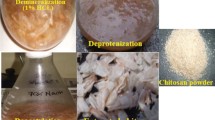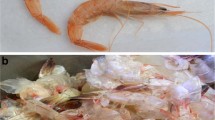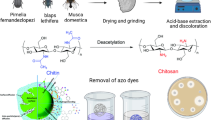Chitosan was isolated from Artemia cysts growing in the Aral Sea. The identity of the obtained chitosan and a reference sample was confirmed by IR spectroscopy. Its molecular weight estimated by viscometry was 162,000 Da. The degree of deacetylation determined by potentiometric titration and the specific surface area of Artemia cyst chitosan estimated using Methylene Blue dye marker were studied as the main indicators of sorption activity. Results of an investigation of the sorption properties of the obtained chitosan for fatty acids and triglycerides as compared to those of reference sorbents showed that chitosan isolated from Artemia cysts could be recommended for use as an effective enterosorbent in vivo.



Similar content being viewed by others
References
Yu. S. Ovodov, Bioorg. Khim., 24(7), 483 – 501 (1998).
R. G. Ovodova, V. V. Golovchenko, A. Ya. Polle, et al., Current Problems with Designing New Drugs of Natural Origin: Proceedings of the Vth International Conference [in Russian], SPbKhFA, St. Petersburg (2001), pp. 260 – 261.
I. M. Gnidoi, Pediatriya, No. 5, 97 – 101 (2000).
R. A. A. Muzzarelli, C. Jeuniaux, and G. W. Gooday, Chitin in Nature and Technology, Plenum Publishing Corporation, New York (1986).
V. S. Yeul and S. S. Rayalu, J. Polym. Environ., 21(2), 606 – 614 (2013).
M. R. Bhuiyan, A. Shaid, M. M. Bashar, et al., Open J. Org. Polym. Mater., 3(4), 87 – 91 (2013).
R. A. A. Muzzarelli (ed.), Natural Chelating Polymers, Pergamon Press, New York (1973), p. 83.
C. K. S. Pillai,W. Paul, and C. P. Sharma, Prog. Polym. Sci., 34, 641 – 678 (2009).
M. N. V. Ravi Kumar, React. Funct. Polym., 46, 1 – 27 (2000).
G. A. F. Roberts, Adv. Chitin Sci., 10, 3 – 10 (2007).
H. Tajik, M. Moradi, S. M. R. Rohani, et al., Molecules, 13, 1263 – 1274 (2008).
F. A. Al Sagheer, M. A. Al-Sughayer, S. Muslim, and M. Z. Elsabee, Carbohydr. Polym., 77, 410 – 419 (2009).
J. Synowiecki and N. A. Al-Khateeb, Crit. Rev. Food Sci. Nutr., 43, 145 – 171 (2003).
M. Hayes, B. Carney, J. Slater, and W. Bruck, Biotechnol. J., 3, 871 – 877 (2008).
M. H. Struszczyk, Polimery, 47, 316 – 325 (2002).
I. Aranaz, M. Mengibar, R. Harris, et al., Curr. Chem. Biol., 3, 203 – 230 (2009).
K. Kurita, K. Tomita, S. Ishi, et al., J. Polym. Sci., Part A: Polym. Chem., 31, 2393 – 2395 (1993).
S. Aiba, Int. J. Biol. Macromol., 13, 40 – 44 (1991).
M. X. Weinhold, J. C. M. Sauvageau, N. Keddig, et al., Green Chem., 11, 498 – 509 (2009).
M. H. Struszczyk and K. J. Struszczyk, Medical Application of Chitin and Its Derivatives, Polish Chitin Society, Lotz, Poland (2007), Monograph XII, pp. 139 – 147.
E. Onsosyen and O. Skaugrud, J. Chem. Technol. Biotechnol., 49, 395 – 404 (1990).
N. Chandy and C. P. Sharma, Biomater. Artif. Cells Artif. Organs, 18, 1 – 24 (1990).
O. Felt, P. Buri, and R. Gurny, Drug Dev. Ind. Pharm., 24, 979 – 993 (1998).
A. I. Gamzazade, et al., Acta Polym., 36(8), 420 – 424 (1985).
M. R. Kasaai, Carbohydr. Polym., 68(3), 477 – 488 (2007).
G. V. Kashina, V. G. Shelepov, and A. I. Mashanov, Vestn. Krasnoyarsk. Gos. Agrar. Univ., No. 5, 238 – 241 (2014).
G. A. Morris, et al., Carbohydr. Polym., 76(4), 616 – 621 (2009).
S. Kumari, et al., Environ. Technol. Innovation, 3, 77 – 85 (2015).
M. V. Ovchinnikova, M. N. Kireev, and A. K. Nikiforov, Probl. Part. Danger. Infect. (Russian Research Anti-Plague Institute “Microbe”), No. 4, 71 – 74 (2014).
M. V. Ovchinnikova, et al., Probl. Part. Danger. Infect. (Russian Research Anti-Plague Institute “Microbe”), No. 2, 83 – 86 (2015).
V. E. Kamskaya, Nauchn. Obozrenie Biol. Nauki, No. 6, 36 – 42 (2016).
E. E. Kuprina, E. V. Osipova, and E. V. Bachischche, Ryb. Prom-st., No. 3, 44 – 46 (2004).
J. Waldstein, et al., in: Chitosan per os, R. A. A. Muzzarelli (ed.), Atec, Grottammare (2000), pp. 65 – 76.
Author information
Authors and Affiliations
Corresponding author
Additional information
Translated from Khimiko-Farmatsevticheskii Zhurnal, Vol. 55, No. 11, pp. 45 – 50, November, 2021.
Rights and permissions
About this article
Cite this article
Oripova, M.Z., Kuzieva, Z.N., Oshchepkova, Y.I. et al. Obtaining Chitosan from Artemia Cysts and Studying its Sorption Properties. Pharm Chem J 55, 1234–1239 (2022). https://doi.org/10.1007/s11094-022-02563-9
Received:
Published:
Issue Date:
DOI: https://doi.org/10.1007/s11094-022-02563-9




